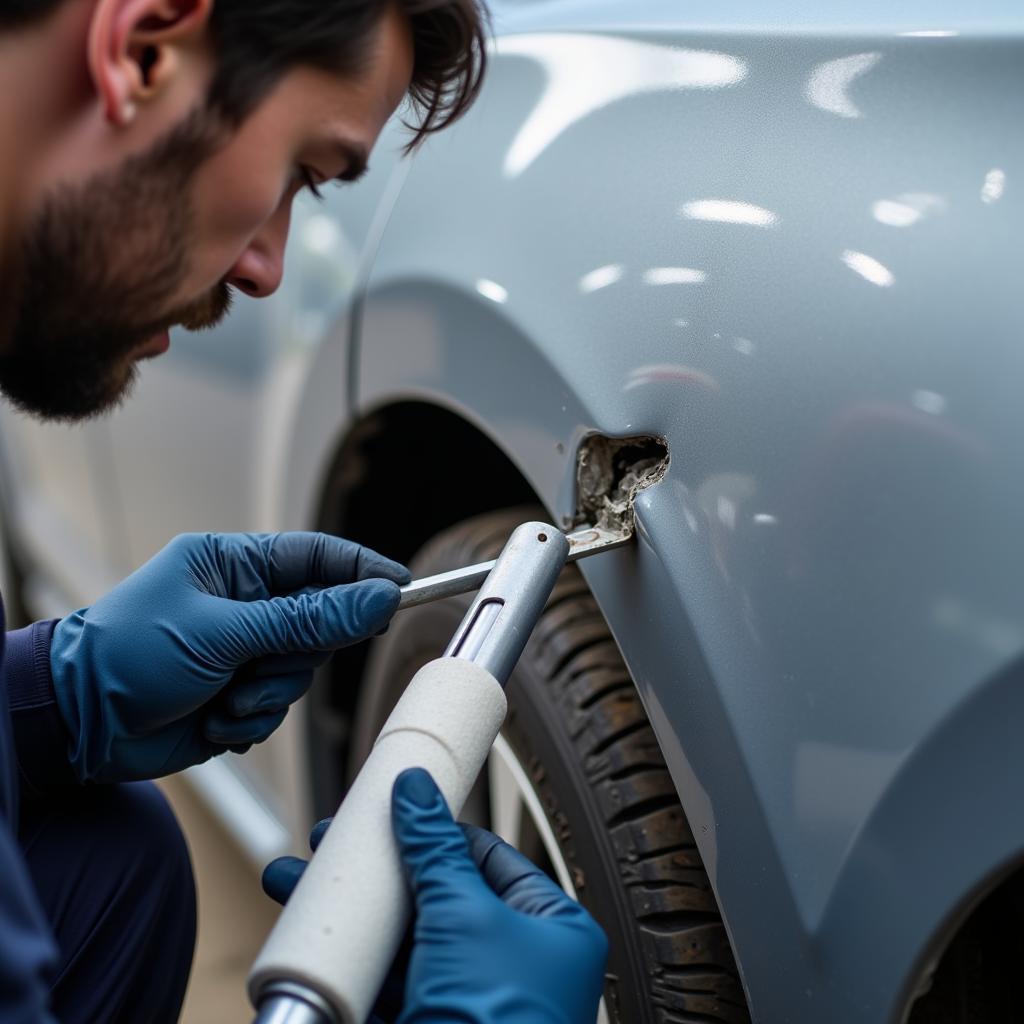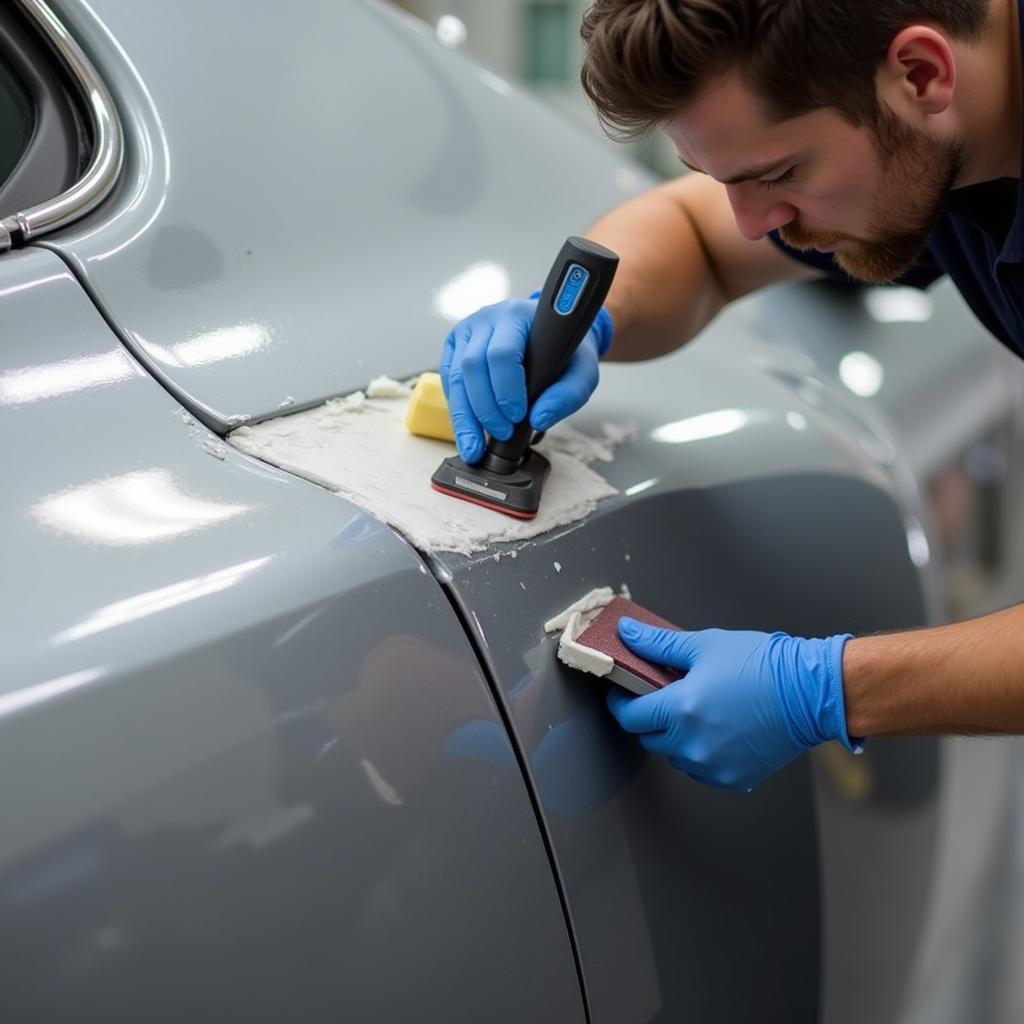Repairing a bent car body can be a complex undertaking, ranging from minor dents to significant structural damage. Understanding the extent of the damage and the appropriate repair methods is crucial for restoring your car’s appearance and structural integrity. This guide will walk you through the process of assessing the damage, choosing the right repair strategy, and understanding the steps involved in fixing a bent car body.
Assessing the Damage to Your Car’s Body
Before embarking on any repairs, a thorough assessment of the damage is essential. This involves identifying the affected areas, the type of damage (dent, crease, or tear), and the depth of the deformation. Is the damage purely cosmetic, or does it impact the car’s frame and functionality? Accurately evaluating the damage will determine the appropriate repair method and the necessary tools and expertise. For instance, a minor dent might be easily fixed with paintless dent repair (PDR), while a more severe bend might require traditional bodywork techniques. Checking for hidden damage, such as behind panels or underneath the car, is also critical. A seemingly small dent can sometimes mask more extensive underlying damage.
 Assessing Car Body Damage for Repair
Assessing Car Body Damage for Repair
Choosing the Right Repair Method
Once you’ve assessed the damage, the next step is to choose the appropriate repair method. Several options exist, ranging from DIY solutions for minor dents to professional interventions for more complex issues. PDR is a popular choice for small dents and dings, as it doesn’t require repainting. For more significant damage, traditional bodywork techniques like hammering, filling, and sanding might be necessary. In cases of severe structural damage, frame straightening or even panel replacement might be required. Selecting the right method depends on factors like the severity of the damage, your budget, and your level of expertise. Remember, attempting complex repairs without proper training and equipment can worsen the damage and compromise the car’s safety.
Repairing a Bent Car Body: Step-by-Step Guide
While minor dent repairs might be manageable for DIY enthusiasts, complex repairs often require professional expertise. However, understanding the general process can help you make informed decisions and communicate effectively with a repair shop. Here’s a general overview of the steps involved in repairing a bent car body:
- Preparing the Damaged Area: This involves cleaning the area, removing any loose paint or rust, and masking off surrounding areas to protect them during the repair process.
- Gaining Access: For dents in difficult-to-reach areas, removing interior panels or trim might be necessary to access the backside of the damaged area.
- Reshaping the Metal: Depending on the repair method, this could involve using specialized tools like dent pullers, hammers, or dollies to reshape the metal back to its original form.
- Filling and Sanding: Once the metal is reshaped, body filler is applied to smooth out any imperfections. After the filler dries, it’s sanded down to create a smooth, even surface.
- Priming and Painting: A primer is applied to prepare the surface for painting. The area is then painted to match the surrounding car body.
- Clear Coat and Finishing: A clear coat is applied to protect the paint and provide a glossy finish. Final polishing and buffing ensure a seamless blend with the rest of the car’s paintwork.
 Car Body Repair Process Involving Filling and Sanding
Car Body Repair Process Involving Filling and Sanding
“Accurate damage assessment is the cornerstone of successful car body repair. Overlooking seemingly minor issues can lead to costly complications down the line,” says renowned auto body expert, John Miller, from Miller’s Auto Body Works. “Investing time in a thorough inspection saves both time and money in the long run.”
DIY vs. Professional Repair: When to Seek Expert Help
While minor dents and dings can be addressed with DIY solutions, more complex damage necessitates professional intervention. If the damage affects structural components, compromises the car’s safety, or requires specialized tools and expertise, seeking professional help is crucial. “Attempting complex repairs without adequate knowledge can exacerbate the damage and create safety hazards,” warns automotive engineer, Sarah Chen, specializing in vehicle structural integrity. “Consulting a qualified professional ensures a proper and safe repair.” Moreover, a professional repair shop can guarantee a high-quality finish and provide warranties on their work.
Conclusion
Repairing a bent car body, whether through DIY methods or professional services, requires careful consideration and proper execution. By understanding the extent of the damage, choosing the appropriate repair method, and following the necessary steps, you can restore your car’s appearance and structural integrity. Remember, a thorough assessment and informed decision-making are crucial for achieving a successful and lasting repair. Knowing how to repair a bent body of a car empowers you to make the best choices for your vehicle.
FAQs
- Can I repair a bent car body myself? Minor dents can often be repaired with DIY methods like PDR kits. However, significant damage requires professional expertise.
- How much does it cost to repair a bent car body? The cost varies depending on the extent of the damage and the chosen repair method. Minor dent repairs can cost a few hundred dollars, while major repairs can cost thousands.
- How long does it take to repair a bent car body? The repair time depends on the complexity of the damage. Minor repairs can be completed in a few hours, while major repairs might take several days or even weeks.
- What are the different methods for repairing a bent car body? Common methods include PDR, traditional bodywork techniques, frame straightening, and panel replacement.
- How do I choose the right repair shop? Look for reputable shops with certified technicians, positive customer reviews, and warranties on their work.
- Can a bent car body affect its safety? Yes, significant damage can compromise the car’s structural integrity and affect its safety in a collision.
- What should I do after a car accident that results in a bent body? Contact your insurance company and seek professional assessment and repair from a qualified auto body shop.
Do you need help with repairing a 767 a110 remote control car? Check out our guide: how to repair 767 a110 remote control car
For more information about car maintenance and repair, explore other articles on our website. You might also find helpful resources on topics like choosing the right car insurance or understanding different types of car damage.
Need help? Contact us via WhatsApp: +1(641)206-8880 or Email: [email protected]. Our customer service team is available 24/7.


